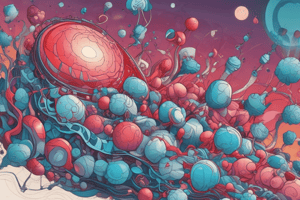Podcast
Questions and Answers
Diabetic ketoacidosis occurs when:
Diabetic ketoacidosis occurs when:
- The pancreas produces excess insulin.
- Insulin is not available in the body. (correct)
- Blood glucose levels rapidly fall.
- The cells rapidly metabolize glucose.
Classic signs and symptoms of hypoglycemia include:
Classic signs and symptoms of hypoglycemia include:
- Cold, clammy skin; bradycardia; hunger; and deep, rapid respirations.
- Warm, dry skin; hunger; abdominal pain; and deep, slow respirations.
- Cool, clammy skin; weakness; tachycardia; and rapid respirations. (correct)
- Warm, dry skin; irritability; bradycardia; and rapid respirations.
In contrast to hypoglycemia, hyperglycemia:
In contrast to hypoglycemia, hyperglycemia:
- Can only be corrected in the hospital setting. (correct)
- Commonly results in excess water retention.
- Is rapidly reversible if oral glucose is given.
- Is a rapidly developing metabolic disturbance.
A man finds his 59-year-old wife unconscious. He states that she takes medications for type 2 diabetes. Your assessment reveals that the patient is unresponsive. You should:
A man finds his 59-year-old wife unconscious. He states that she takes medications for type 2 diabetes. Your assessment reveals that the patient is unresponsive. You should:
Hemoglobin is:
Hemoglobin is:
Type 1 diabetes:
Type 1 diabetes:
During your assessment of a 70-year-old woman who takes blood-thinning medication, you should suspect that she has:
During your assessment of a 70-year-old woman who takes blood-thinning medication, you should suspect that she has:
Patients with thrombophilia are at an increased risk for:
Patients with thrombophilia are at an increased risk for:
Common signs and symptoms of severe hyperglycemia include all of the following, EXCEPT:
Common signs and symptoms of severe hyperglycemia include all of the following, EXCEPT:
You are treating a 40-year-old male with a documented blood sugar reading of 480 mg/dL. The patient is semiconscious and breathing shallowly. Definitive treatment for this patient includes:
You are treating a 40-year-old male with a documented blood sugar reading of 480 mg/dL. The patient is semiconscious and breathing shallowly. Definitive treatment for this patient includes:
Flashcards are hidden until you start studying
Study Notes
Diabetic Ketoacidosis
- Occurs when insulin is not available in the body, leading to high blood glucose levels and ketone production.
Hypoglycemia
- Classic signs include cool, clammy skin, weakness, tachycardia, and rapid respirations.
- Immediate recognition of symptoms is critical for effective intervention.
Hyperglycemia
- Unlike hypoglycemia, hyperglycemia can only be corrected in a hospital setting.
- It is characterized by prolonged high blood sugar levels.
Patient Assessment
- For an unconscious patient with a history of type 2 diabetes who has not eaten, open and maintain the airway and assess breathing first.
- Medical identification tags can provide valuable information but should not delay urgent care.
Hemoglobin Function
- Found within red blood cells, hemoglobin is essential for carrying oxygen throughout the body.
Type 1 Diabetes
- Type 1 diabetes is characterized by no insulin production by the body.
- It is distinct from Type 2 diabetes, which can be treated with medications like metformin.
Deep Vein Thrombosis
- Patients on blood-thinning medications and wearing compression stockings may have deep vein thrombosis (DVT).
Thrombophilia
- Increases the risk for acute arterial rupture, a serious condition that can lead to life-threatening complications.
Severe Hyperglycemia Symptoms
- Includes warm, dry skin, rapid thready pulse, and acetone breath odor.
- Cool, clammy skin is not a symptom of severe hyperglycemia.
Treatment for Severe Hyperglycemia
- For a patient with a high blood sugar reading (e.g., 480 mg/dL) who is semiconscious, insulin is required for definitive treatment.
Studying That Suits You
Use AI to generate personalized quizzes and flashcards to suit your learning preferences.




